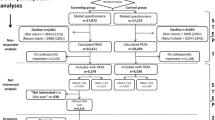Abstract
Objective: The aim of the present study was to compare the beliefs, knowledge, and health-related behaviors of first-degree relatives (FDRs) of osteoporotic women with a comparison group of women not having a FDR with osteoporosis. Research design: Telephone interviews. Participants: Participants were 172 women (48 FDRs and 124 comparisons), recruited by a systematic sampling from the list of all women aged 40+ attending an outpatient screening program at a large tertiary medical center in Israel. Methods: Information was collected regarding participants' perceived susceptibility to develop osteoporosis, perceived concerns, and perceived prevention optimism. Additionally, information was collected regarding knowledge about osteoporosis, and participation in screening and preventive behavior. Results: Participants in the FDR group reported higher perceived susceptibility and higher concerns about developing the disease than participants in the comparison group. A higher proportion of FDRs reported engaging in screening behavior, but no differences were found in preventive behaviors. Screening behavior was associated with perceived concerns and age for members of the comparison group, and with age for FDRs. Conclusions: FDRs are characterized by greater perceived vulnerability and concerns. However, they are no more likely to engage in preventive behaviors or have more knowledge about the disease. These findings stress the importance of expanding efforts to increase the knowledge and awareness of at-risk persons.
Similar content being viewed by others
References
NIH Consensus Development Panel on Osteoporosis Prevention, Diagnosis and Therapy (2001) Osteoporosis prevention, diagnosis and therapy. JAMA 285(6):785–795
Danielson ME, Cauley JA, Baker CE et al (1999) Familial resemblance of bone mineral density (BMD) and calcaneal ultrasound attenuation: The BMD in Mothers and Daughters Study. J Bone Miner Res 14(1):102–110
Yeap SS, Beaumont M, Bennett A et al (1998) Genetic and environmental factors affecting bone mineral density in large families. Postgrad Med J 74(872):349–354
Deng HW, Chen WM, Recker S et al (2000) Genetic determinants of Colle's fracture and differential bone mass in women with and without Colle's fracture. J Bone Miner Res 15:1243–1252
Alagna SW, Morokoff PJ, Bevett JM, Reddy DM (1987) Performance of breast self-examination by women at high risk for breast cancer. Women Health 12:29–46
Bratt O, Kristoffersson U, Lundgren R, Olsson H (1997) Sons of men with prostate cancer: their attitudes regarding possible inheritance of prostrate cancer, screening and genetic testing. Urology 50:360–365
Miller SM, Diefenbach MA, Kruus LK et al (2001) Psychological and screening profiles of first-degree relatives of prostate cancer patients. J Behav Med 24(3):247–258
Laughler DC, Kean TJ, Esparza D et al (1981) The breast self-examination practices of high risk women: implications for patient education. Pat Counsel Health Educ 3(3):103–107
Smith GE, DeHaven MJ, Grundig JP, Wilson GR (1997) African-American males and prostate cancer: assessing knowledge levels in the community. J Nat Med Assoc 89:387–391
Constanza M, Stoddard A, Caw VP, Zopk JG (1992) The risk factors of age and family history and their relationship to screening mammography utilization. J Am Geriatr Soc 40:774–778
Lerman C, Daly M, Sands C et al (1993) Mammography adherence and psychological distress among women at risk for breast cancer. J Nat Cancer Inst 85(13):1074–1080
Baider L, Ever-Hadani P, Kaplan De-Nour A (1999) Psychological distress in health women with familial breast cancer: Like mother, like daughter? Int J Psychiatry Med 29(4):411–420
Roberts JS, Connell C (2000) Illness representations among first-degree relatives of people with Alzheimer's disease. Alzheimer Dis Rel Dis 14(3):129–136
Ailinger RL, Emerson J (1998) Women's knowledge of osteoporosis. Appl Nurs Res 11(3):111–114
Satterfield T, Johnson SM, Slovic P, Nei, N, Schein JR (2000) Perceived risks and reported behaviors associated with osteoporosis and its treatment. Women Health 31(4):21–39
Decruyenaere M, Evers-Kiebooms G, Welkenhuysen M et al (2000) Cognitive representations of breast cancer, emotional distress and preventive health behaviour: A theoretical perspective. Psycho-oncology. 9:528–536
Rimes KA, Salkovskis PM, Shipman AJ (1999) Psychological and behavioural effects of bone density screening for osteoporosis. Psychol Health 14:585–608
Campbell MK, Torgerson DJ, Thomas RE et al (1998) Direct disclosure of bone density results to patients: Effect on knowledge of osteoporosis risk and anxiety level. Osteoporos Int 8:584–590
Siebzehner MI (2000) Consensus statement on prevention and treatment of osteoporosis. Isr Med Assoc J 2:397–401
Gilbar O, Borovik R (1998) How daughters of women with breast cancer cope with the threat of the illness. Behav Med 24:115–121
Audrain J, Schwartz M, Herrera J et al (2001) Physical activity in first-degree relatives of breast cancer patients. J Behav Med 24(6):587–603
Hobson EE, Ralston SH (2001) Role of genetic factors in the pathophysiology and management of osteoporosis. Clin Endocrinol 54: 1–9
Author information
Authors and Affiliations
Corresponding author
Rights and permissions
About this article
Cite this article
Werner, P., Olchovsky, D., Erlich-Gelaki, H. et al. First-degree relatives of persons suffering from osteoporosis: beliefs, knowledge, and health-related behavior. Osteoporos Int 14, 306–311 (2003). https://doi.org/10.1007/s00198-002-1357-0
Received:
Accepted:
Published:
Issue Date:
DOI: https://doi.org/10.1007/s00198-002-1357-0




